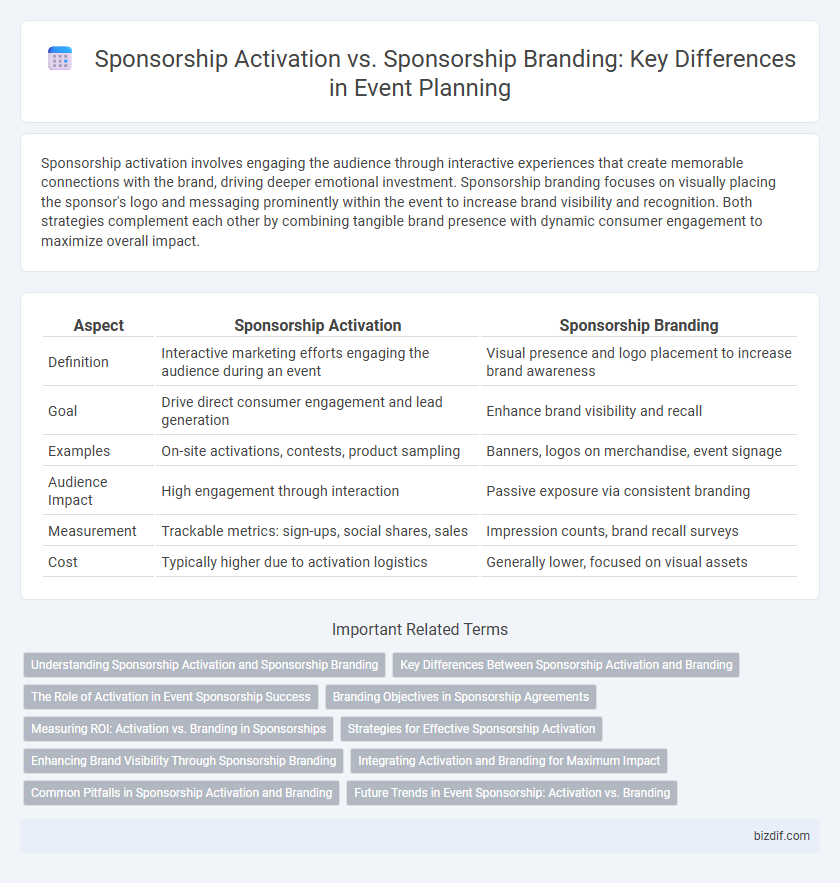Sponsorship activation involves engaging the audience through interactive experiences that create memorable connections with the brand, driving deeper emotional investment. Sponsorship branding focuses on visually placing the sponsor's logo and messaging prominently within the event to increase brand visibility and recognition. Both strategies complement each other by combining tangible brand presence with dynamic consumer engagement to maximize overall impact.
Table of Comparison
| Aspect | Sponsorship Activation | Sponsorship Branding |
|---|---|---|
| Definition | Interactive marketing efforts engaging the audience during an event | Visual presence and logo placement to increase brand awareness |
| Goal | Drive direct consumer engagement and lead generation | Enhance brand visibility and recall |
| Examples | On-site activations, contests, product sampling | Banners, logos on merchandise, event signage |
| Audience Impact | High engagement through interaction | Passive exposure via consistent branding |
| Measurement | Trackable metrics: sign-ups, social shares, sales | Impression counts, brand recall surveys |
| Cost | Typically higher due to activation logistics | Generally lower, focused on visual assets |
Understanding Sponsorship Activation and Sponsorship Branding
Sponsorship activation involves strategic efforts to engage the target audience by creating interactive experiences and marketing campaigns that bring the sponsor's brand to life during an event. Sponsorship branding focuses on the visual and logo placement aspects, ensuring prominent visibility of the sponsor's identity through signage, merchandise, and digital displays. Understanding both concepts allows event planners to maximize ROI by combining brand awareness with active consumer participation.
Key Differences Between Sponsorship Activation and Branding
Sponsorship activation involves interactive campaigns and activities designed to engage the audience directly, driving immediate consumer action and enhancing brand experience at the event. Sponsorship branding focuses on visual presence, such as logos, banners, and product placements, aiming to increase brand visibility and recognition over time. Activation creates measurable engagement metrics, while branding primarily builds long-term brand awareness.
The Role of Activation in Event Sponsorship Success
Sponsorship activation plays a critical role in event sponsorship success by transforming branding into interactive experiences that engage attendees and create memorable impressions. Unlike sponsorship branding, which emphasizes logo placement and passive visibility, activation involves strategic activities such as sampling, contests, and immersive installations that drive direct consumer engagement. Effective activation not only enhances brand recall but also generates measurable ROI through increased audience interaction and data capture.
Branding Objectives in Sponsorship Agreements
Sponsorship branding in event planning focuses on maximizing visibility and reinforcing brand identity through logos, messaging, and strategic placement to achieve targeted marketing outcomes. Sponsorship activation goes beyond visibility to engage audiences directly, creating interactive experiences that drive emotional connections and consumer behavior. Branding objectives in sponsorship agreements prioritize measurable brand awareness, equity enhancement, and audience reach through activated touchpoints and consistent brand representation.
Measuring ROI: Activation vs. Branding in Sponsorships
Measuring ROI in sponsorship activation involves tracking direct consumer engagement and sales conversions through interactive campaigns and event experiences, offering quantifiable data. In contrast, sponsorship branding focuses on long-term brand awareness and perception uplift, which requires analyzing brand sentiment, reach, and media metrics. Activation delivers immediate performance insights, while branding investments emphasize sustained brand equity and audience connection.
Strategies for Effective Sponsorship Activation
Sponsorship activation focuses on engaging audiences through interactive experiences and personalized content, driving measurable brand interaction beyond static sponsorship branding, which typically involves logo placement and passive visibility. Effective activation strategies include leveraging digital platforms, immersive event elements, and real-time social media campaigns to create memorable brand connections. Prioritizing data-driven insights and tailored messaging enhances audience engagement and maximizes ROI in sponsorship activation efforts.
Enhancing Brand Visibility Through Sponsorship Branding
Sponsorship branding focuses on embedding a brand's identity prominently within an event's visual and experiential elements to maximize exposure and recognition among target audiences. Enhancing brand visibility through sponsorship branding involves strategic placement of logos, branded zones, and interactive displays that create memorable touchpoints throughout the event. This approach drives stronger brand recall and engagement by continuously reinforcing the sponsor's presence in the minds of attendees.
Integrating Activation and Branding for Maximum Impact
Sponsorship activation involves interactive experiences that engage attendees and create memorable brand interactions, while sponsorship branding focuses on visual presence through logos, signage, and promotional materials. Integrating activation and branding enhances event impact by combining visual exposure with meaningful participant engagement, driving stronger brand recall and loyalty. Leveraging this dual approach maximizes sponsor value and elevates overall event success.
Common Pitfalls in Sponsorship Activation and Branding
Common pitfalls in sponsorship activation include insufficient audience engagement and lack of tailored experiences, which diminish the sponsor's impact beyond mere logo placement. In sponsorship branding, overreliance on visual presence without integrating the brand's core message often results in low recall and weak emotional connection. Effective sponsorship strategies require balancing immersive activation efforts with consistent, message-driven branding to maximize return on investment.
Future Trends in Event Sponsorship: Activation vs. Branding
Future trends in event sponsorship emphasize a shift from passive branding to dynamic sponsorship activation, leveraging interactive technologies such as augmented reality and AI-driven engagement tools to create immersive attendee experiences. Data analytics and personalized content enable brands to measure activation impact more accurately than traditional branding, driving higher ROI and deeper consumer connections. As experiential marketing evolves, event sponsorship will increasingly prioritize activation strategies that foster real-time consumer interaction and lasting brand loyalty over static logo placements.
Sponsorship activation vs Sponsorship branding Infographic

 bizdif.com
bizdif.com